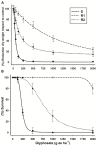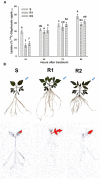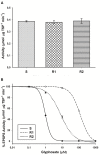Target and Non-target Site Mechanisms Developed by Glyphosate-Resistant Hairy beggarticks (Bidens pilosa L.) Populations from Mexico
- PMID: 27752259
- PMCID: PMC5046737
- DOI: 10.3389/fpls.2016.01492
Target and Non-target Site Mechanisms Developed by Glyphosate-Resistant Hairy beggarticks (Bidens pilosa L.) Populations from Mexico
Abstract
In 2014 hairy beggarticks (Bidens pilosa L.) has been identified as being glyphosate-resistant in citrus orchards from Mexico. The target and non-target site mechanisms involved in the response to glyphosate of two resistant populations (R1 and R2) and one susceptible (S) were studied. Experiments of dose-response, shikimic acid accumulation, uptake-translocation, enzyme activity and 5-enolpyruvyl shikimate-3-phosphate synthase (EPSPS) gene sequencing were carried out in each population. The R1 and R2 populations were 20.4 and 2.8-fold less glyphosate sensitive, respectively, than the S population. The resistant populations showed a lesser shikimic acid accumulation than the S population. In the latter one, 24.9% of 14C-glyphosate was translocated to the roots at 96 h after treatment; in the R1 and R2 populations only 12.9 and 15.5%, respectively, was translocated. Qualitative results confirmed the reduced 14C-glyphosate translocation in the resistant populations. The EPSPS enzyme activity of the S population was 128.4 and 8.5-fold higher than the R1 and R2 populations of glyphosate-treated plants, respectively. A single (Pro-106-Ser), and a double (Thr-102-Ile followed by Pro-106-Ser) mutations were identified in the EPSPS2 gene conferred high resistance in R1 population. Target-site mutations associated with a reduced translocation were responsible for the higher glyphosate resistance in the R1 population. The low-intermediate resistance of the R2 population was mediated by reduced translocation. This is the first glyphosate resistance case confirmed in hairy beggarticks in the world.
Keywords: 5-enolpyruvyl shikimate-3-phosphate synthase; Bidens pilosa; EPSPS2; TIPS mutation; glyphosate translocation; resistance mechanisms.
Figures





Similar articles
-
First Resistance Mechanisms Characterization in Glyphosate-Resistant Leptochloa virgata.Front Plant Sci. 2016 Nov 18;7:1742. doi: 10.3389/fpls.2016.01742. eCollection 2016. Front Plant Sci. 2016. PMID: 27917189 Free PMC article.
-
From tolerance to resistance: mechanisms governing the differential response to glyphosate in Chloris barbata.Pest Manag Sci. 2018 May;74(5):1118-1124. doi: 10.1002/ps.4874. Epub 2018 Mar 5. Pest Manag Sci. 2018. PMID: 29384251
-
Identifying Chloris Species from Cuban Citrus Orchards and Determining Their Glyphosate-Resistance Status.Front Plant Sci. 2017 Nov 15;8:1977. doi: 10.3389/fpls.2017.01977. eCollection 2017. Front Plant Sci. 2017. PMID: 29187862 Free PMC article.
-
Reduced Glyphosate Movement and Mutation of the EPSPS Gene (Pro106Ser) Endow Resistance in Conyza canadensis Harvested in Mexico.J Agric Food Chem. 2023 Mar 22;71(11):4477-4487. doi: 10.1021/acs.jafc.2c07833. Epub 2023 Mar 9. J Agric Food Chem. 2023. PMID: 36892583
-
The history and current status of glyphosate.Pest Manag Sci. 2018 May;74(5):1027-1034. doi: 10.1002/ps.4652. Epub 2017 Aug 11. Pest Manag Sci. 2018. PMID: 28643882 Review.
Cited by
-
Glyphosate-Resistant Parthenium hysterophorus in the Caribbean Islands: Non Target Site Resistance and Target Site Resistance in Relation to Resistance Levels.Front Plant Sci. 2016 Dec 6;7:1845. doi: 10.3389/fpls.2016.01845. eCollection 2016. Front Plant Sci. 2016. PMID: 27999586 Free PMC article.
-
The Molecular, Morphological and Genetic Characterization of Glyphosate Resistance in Conyza bonariensis from South Africa.Plants (Basel). 2022 Oct 24;11(21):2830. doi: 10.3390/plants11212830. Plants (Basel). 2022. PMID: 36365283 Free PMC article.
-
Mechanisms of evolved herbicide resistance.J Biol Chem. 2020 Jul 24;295(30):10307-10330. doi: 10.1074/jbc.REV120.013572. Epub 2020 May 19. J Biol Chem. 2020. PMID: 32430396 Free PMC article. Review.
-
The Invasive Mechanisms of the Noxious Alien Plant Species Bidens pilosa.Plants (Basel). 2024 Jan 25;13(3):356. doi: 10.3390/plants13030356. Plants (Basel). 2024. PMID: 38337889 Free PMC article. Review.
-
Investigation of the target-site resistance of EPSP synthase mutants P106T and T102I/P106S against glyphosate.RSC Adv. 2020 Dec 16;10(72):44352-44360. doi: 10.1039/d0ra09061a. eCollection 2020 Dec 9. RSC Adv. 2020. PMID: 35517162 Free PMC article.
References
-
- Alarcón-Reverte R., García A., Urzúa J., Fischer A. J. (2013). Resistance to glyphosate in junglerice (Echinochloa colona) from California. Weed Sci. 61 48–54. 10.1614/WS-D-12-00073.1 - DOI
-
- Alarcón-Reverte R., García R., Watson S. B., Abdallah I., Sabaté S., Hernández M. J., et al. (2015). Concerted action of target-site mutations and high EPSPS activity in glyphosate-resistant junglerice (Echinochloa colona) from California. Pest Manag. Sci. 71 996–1007. 10.1002/ps.3878 - DOI - PubMed
LinkOut - more resources
Full Text Sources
Other Literature Sources

